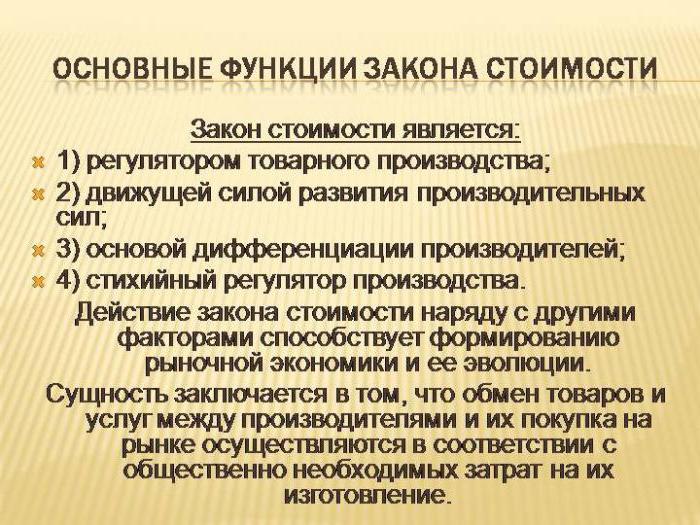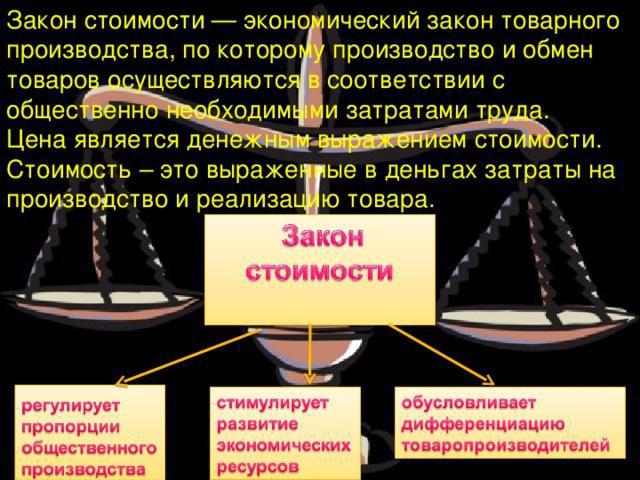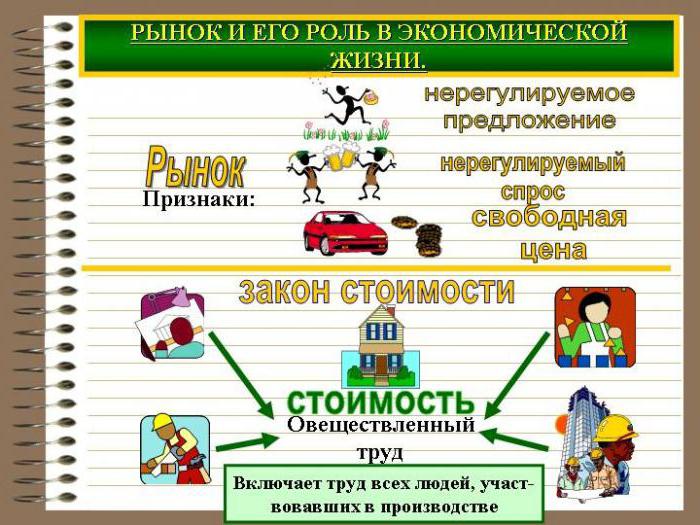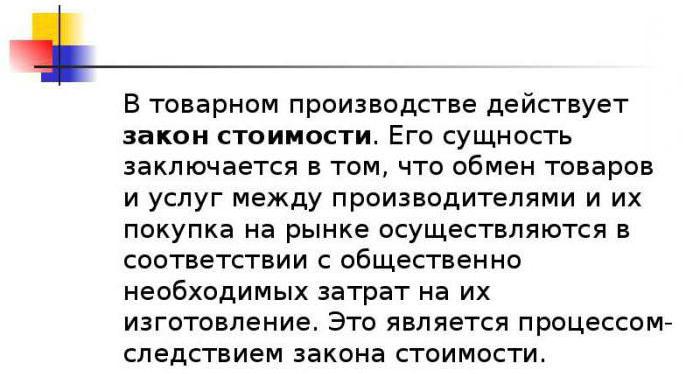The relations of modern commodity producers who create profit by exchanging goods are regulated by certain norms. The most important of these is the law of value. It is intended to regulate the relations of producers of goods at the level of commodity value, which is measured by socially necessary labor costs.
The law begins in the production sphere, but its mechanism of action is such that it is found on the market during the exchange of goods. This suggests that production and circulation are shaky, with some contradictions, but still unity.
The essence of the law
The basic concepts of this law are as follows:
- the value of any manufactured goods is determined on the basis of the costs of socially necessary working time;
- individual value, which is the basis of price, is reduced to social value, individual labor costs - to socially necessary;
- equivalent goods are exchanged, the same amount of socially necessary working time is spent on their production.
The laws of economics interpret the law of value as the law of prices. It took shape more than 7 thousand years ago with the advent of commodity production and exchange. Therefore, the law of value is the legal norm of commodity production. According to her, it is in accordance with the socially necessary labor costs that exchange and production of products should take place. Or simply, this is a law that says that the price of a product must fully correspond to the value.
The law of value and its functions
The functional significance of the law of value lies in the economic stimulation of the development and growth of productive forces. Consequently, in commodity production this law performs several functions.

Function one
Accounting for social labor. It occurs through the formation of socially necessary costs of the work process.
This function is gradually being implemented in the whole mechanism of market management. The purpose of this function is to take value as the measure of wealth, which is the totality of goods available in society. But it is prices that are used to measure wealth, since value is manifested through them.
Second function
The law of value is a recognized engine of spontaneous processes in the mechanism of productive forces in the production of goods. This function is called stimulating.
This happens because manufacturers are more profitable in the sale of marketable products, the individual value of which is less than the public. This situation allows not only to reimburse the labor expended, but also to receive additional income from above.

The desire of producers of goods to receive additional profit stimulates them by changing the technological process and introducing new technology to reduce individual cost. The competitive nature of a market economy encourages other manufacturers of similar products to reduce the cost of their goods in the same way. As a result, new technology occupies its own niche and is becoming very common. This is how the laws of economics spontaneously, and the main one is the law of value, develop the productive forces of society.
Function three
Also, the law of value spontaneously regulates the production of goods. And the main condition here is price dynamics. Through the fluctuation of market prices, processes of movement and overflow of production factors (namely labor and capital) from one branch of the national economy to another occur.This regulates the ratio of the output of marketable products.
Social labor should be distributed in specially calculated proportions between sectors in order to fully satisfy the needs of society. For example, the volume of coal production must be correlated with the amount of smelting of ferrous metals, and steel production should be guided by the number of cars manufactured from this steel, etc. But the spontaneity of this mechanism constantly violates the necessary proportionality. Therefore, some goods are now in abundance, then in shortage.
Fourth function
The law of value is considered the basic rule of differentiation of producers. But in no case does it condition economic equality between producers of consumer goods. It is the law of value that creates inequality in their sphere. The reason is simple: the discrepancy between individual value and social.
The unification of some producers of goods, the enrichment of others and the ruin of others are also the result of the spontaneity of the law of value. The differentiation of commodity producers leads to it, leading to an unaccountable transition of simple commodity production to capitalist production.

Fifth function
Conscious regulation of a highly associated economy. Modern society consciously applies the principles of the law of value to regulate the processes of pricing, commodity and money circulation, as well as in foreign trade.
The role of the law of value in the economy
The principles of its action are not absolute. The law of value, the definition it underlines, is limited. It provides an opportunity to understand the behavior of the producer and / or seller, in how the value and price appear. The law of value cannot explain the reasons for the economic behavior of another subject of market relations - the buyer. This makes it limited.

The secret is as follows. Producers of goods plan to sell products at a price that would fully offset costs and make a profit. That is, the behavior of the producer is entirely subject to the law of value. The buyer is not at all interested in the costs invested in the goods by the manufacturer. The consumer's goal is the low purchase price, its usefulness and the importance or unimportance of its acquisition. It is no longer the law of value that works here, but the law of supply and demand.
World economic processes
The law of value extends to world economic and economic relations. Only in this case, national value plays the role of individual. From it comes the formation of international value. A country with high labor productivity has relatively low labor costs and makes a profit by selling goods at an educated international value. At the same time, a state with a high individual value loses.

But this does not mean that foreign trade relations are not at all beneficial to the state with labor productivity lower than that of the rest. If the country itself receives goods cheaper than it could produce them, then low labor productivity will be appropriate. Here, the ratio of the national value of exported and imported products to international comes to the fore, while the value of the value does not matter.